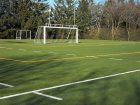
Features
Profiles
4G pitches take artificial turf to new safety levels
Current technology blends synthetic and natural turf blades for a hardier hybrid playing surface
June 9, 2017 By Turf and Rec Staff
The fundamentals of football (soccer) have changed little since it was established in 1863. However, with soaring salaries and the introduction of new technology, pretty much everything else has – right down to the pitches they play on.
So how have football pitches changed over the years? U.K. garden and lawn dressing retailer Compost Direct has tracked the evolution of the football pitch from grass roots to 4G technology.
Grass: the beginning
As you’d expect, football started out on grass, a pitch the sport would rely on right up to the present day. Pitches are heavily reliant on good levels of light and watering, requiring high levels of maintenance. Because of the delicacy of grass, intensive use can leave pitches far from perfect.
Professional football clubs hire groundsmen to ensure their pitch is match-ready. High-profile roles can earn up to £42,000, so it’s clearly big business.
The rise of artificial turf
While artificial turf is commonplace now, it was unheard of before 1960. It was invented by David Chaney, head of the RTP research team, and was made from polypropylene or nylon fibre attached to a concrete or asphalt base.
This type of turf was first installed and used in 1966 at Houston’s Astrodome. U.K. teams soon became aware of the benefits this low-maintenance turf would bring, with Queens Park Rangers, Luton Town, Oldham Athletic and Preston North End all replacing their natural grass pitches.
However, as it was first-generation, this type of pitch had many negatives. The harshness of the pitch was detrimental to players’ joints, while sliding tackles often led to friction burn. In terms of matches and player performance, footballs were difficult to control and fatigue levels were higher.
Surprisingly, these pitches were played on until 1995, when they were officially banned from English professional football. Once again, Premier League pitches were replaced with natural turf.
The 3G revolution
After the failings of the first generation of artificial turf, the 3G pitch emerged victorious in the early 2000s. Learning from the mistakes of previous pitches, the turf was created to mirror real grass, with longer, thinly spaced tufts to ease the impact on players. Likewise, sand infills and rubber granules deliver both bounce and support.
3G pitches are common in the U.K., with 780 registered in total for the 2016/17 season, according to data from the FA. They are primarily used by lower league sides and as training pitches due to their all-year-round appeal.
Moving forward with 4G
4G pitches take the next step forwards from 3G pitches. They contain a mixture of artificial and natural turf and are created by growing natural grass around artificial blades. They work by combining the benefits of both natural and artificial pitches.
The pitches are hardwearing and low-maintenance, as well as being soft underfoot and having minimal impact on how the player interacts with the ball.
Although not officially recognized as of yet by the Football Association, 4G pitches are growing in popularity and are set to be the next stage in artificial turf.
The 4G pitches such as the Desso Grassmaster contain a mixture of artificial and natural turf, injecting the artificial blades first and then growing the natural grass around them so that they bind to the roots. The system was used at the 2010 FIFA World Cup – the first time in history that a World Cup was played on pitches partly made up of artificial grass.
The success of the new technology prompted top premier league clubs such as Manchester City, Arsenal and Tottenham to adopt this turf in their stadiums. It seems that the future of football turf is to find the perfect blend of both natural and artificial.
For the 2014 FIFA World Cup, Brazil invested in the Desso Grassmaster hybrid pitch for the Arena de Sao Paulo.
Benefits of artificial grass:
- Hardwearing
- Easy to maintain
- Does not need sunlight to thrive, which is ideal for steep-sided stadia
- Resistant to inclement weather, including wet, sunny and colder climates
Benefits of natural grass:
- Soft underfoot
- Does not change the way a player interacts with the ball
- Does not produce skin abrasions when tackling
Visit Compost Direct’s website here.
Print this page
